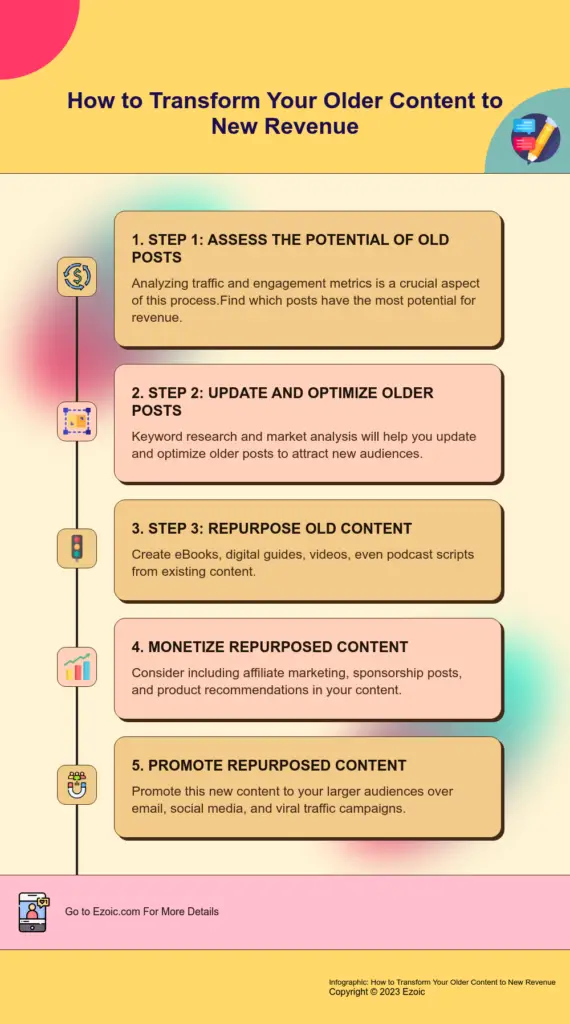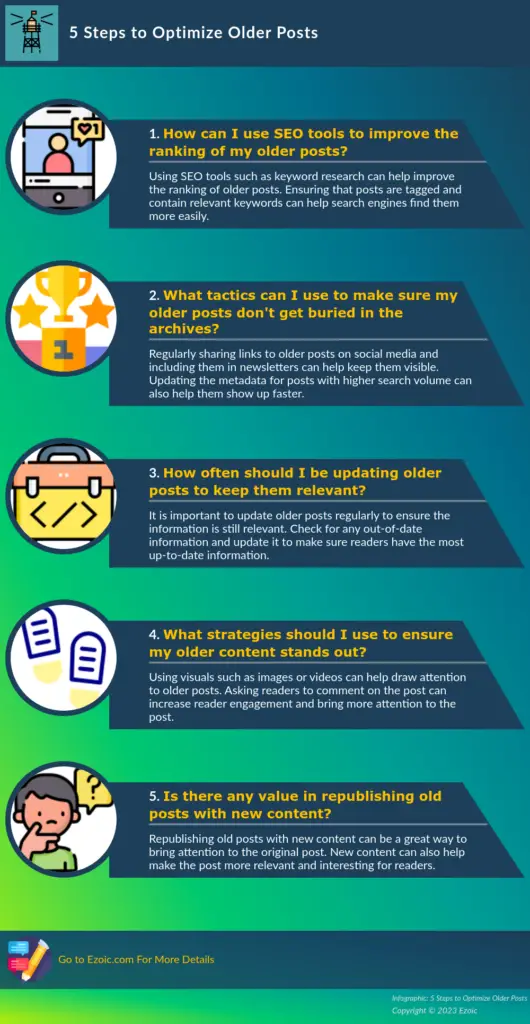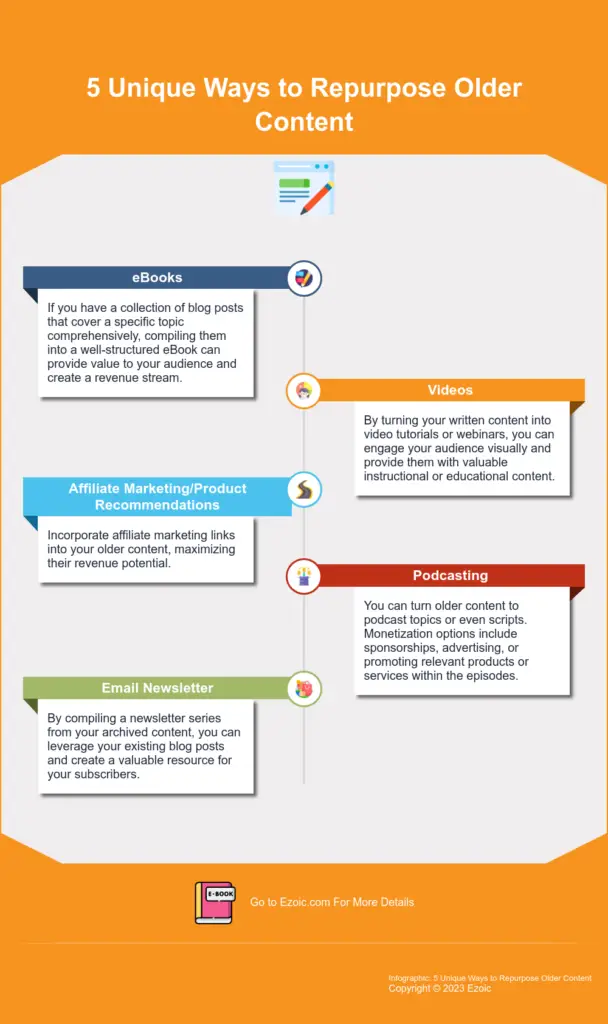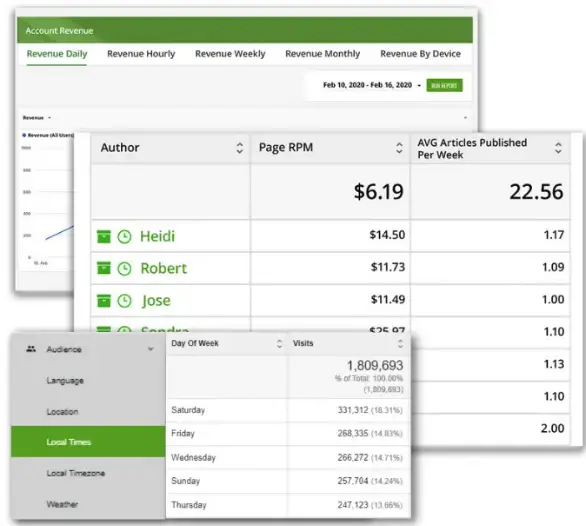
How to Transform Your Old Content Into New Revenue

Get helpful updates in your inbox
As a publisher, website owner, and content creator, you’ve undoubtedly spent years honing your craft, researching your niche, and producing content for your audience. Your old content may not have gone viral, it may have gotten little to no traffic at all; but your old content has enormous potential to become new revenue. Through repurposing, SEO optimizing, and the use of AI, you can transform your older content, blog posts, and ideas into new content that can earn you significant revenue.
For many years, I wrote and published content. I had hundreds of blog posts — all of which received almost no traffic. But I was able to turn that content into new revenue in several new ways. First, I was able to package that content into new products (eBooks, online courses, guides, PDFs, etc.) with a fresh coat of paint, more relevant for the current audience. I was also able to use AI to turn my old written posts into several new forms of content (like short form video, long form video, social media posts, etc.). All without having to write any new content! The result was a pleasant surprise: earning significant revenue from content I’d already made.
There are countless ways to use your older content to earn more revenue. Here’s how.
Assessing the Potential of Your Old Content
When it comes to turning old blog posts into new revenue, the first step is to assess the potential of your existing content. Analyzing traffic and engagement metrics is a crucial aspect of this process. By delving into the data, you can gain valuable insights into the performance of your blog posts and identify opportunities for improvement.
One key metric to consider is website traffic. Take a look at the number of page views, unique visitors, and overall traffic trends for each older blog post. Identify the posts that consistently attract high traffic, as these are the ones that hold the greatest potential for generating revenue in new ways. Additionally, pay attention to the sources of traffic, such as organic search, social media, or referrals, to understand which channels are driving the most visitors to your content.
Engagement metrics are equally important. Evaluate metrics such as average time spent on page, bounce rate, and social shares to gauge how effectively your old blog posts are capturing and retaining audience interest. High engagement rates indicate that your content resonates with readers, making it a prime candidate for repurposing and monetization.

During the assessment process, it’s essential to identify evergreen and high-performing content. Evergreen content refers to articles that remain relevant and valuable over time, offering enduring insights to readers. These posts often rank well in search engines and continue to attract traffic long after their publication. By recognizing evergreen content among your old blog posts, you can capitalize on its enduring popularity and find ways to leverage it for new revenue streams.
In addition to evergreen content, pinpoint the blog posts that have historically performed exceptionally well. These could be articles that received significant engagement, generated a high number of conversions, or attracted a large number of backlinks. By identifying such high-performing content, you can strategize ways to repurpose and monetize it further, building on its past success.
While assessing the potential of your old blog posts, it’s crucial to evaluate content gaps and opportunities within your niche. Look for topics that are highly relevant and in-demand but haven’t been covered extensively on your blog. This identification process can be done through keyword research, competitor analysis, and understanding the needs and preferences of your target audience.
By identifying content gaps, you can create new blog posts or repurpose existing ones to address those areas of interest. This allows you to tap into untapped markets, attract new readers, and ultimately generate more revenue. Additionally, by keeping an eye on emerging trends and topics, you can stay ahead of the curve and position your blog as a go-to resource in your industry.
Evaluating content opportunities also involves assessing the potential for cross-linking and interlinking between your old blog posts. By strategically linking related articles together, you can enhance the user experience, improve SEO rankings, and encourage visitors to explore more of your content. This internal linking strategy not only boosts engagement but also facilitates the monetization of your blog posts by directing readers to relevant products, services, or affiliate links.
Assessing the potential of your old blog posts is a crucial step in turning them into new revenue streams. By analyzing traffic and engagement metrics, identifying evergreen and high-performing content, and evaluating content gaps and opportunities, you can unlock the full potential of your existing content and maximize its value. With a strategic approach, you can breathe new life into your old blog posts and create additional revenue sources for your website.
Updating and Optimizing Old Content
To maximize the revenue potential of your old blog posts, conducting keyword research is essential. Keyword research helps you identify relevant search terms and phrases that your target audience is actively using to find content. By incorporating these keywords strategically into your old blog posts, you can improve their visibility in search engine results and attract organic traffic.
Begin by using keyword research tools such as Ezoic’s NicheIQ to discover keywords related to your blog post’s topic. Look for keywords with a good search volume and relatively low competition. Long-tail keywords can be especially valuable as they often indicate specific user intent and can result in higher conversion rates.
When updating your old blog posts, aim to naturally incorporate these researched keywords into the title, headings, subheadings, and throughout the body of the content. However, be cautious not to overstuff keywords, as this can negatively impact the user experience and harm your SEO rankings. Strive for a balance between optimization and providing valuable, readable content.

Old blog posts may contain outdated information and statistics, which can undermine their credibility and relevance. Refreshing this outdated content is crucial to maintain the accuracy and usefulness of your posts. It’s especially important for evergreen content that continues to attract traffic over time.
Review each old blog post and verify the accuracy of the information presented. Update any statistics, data, or examples that have changed since the post’s original publication. Additionally, ensure that any external links within the post are still active and lead to relevant and up-to-date sources.
By keeping your content current, you not only enhance its value to readers but also improve its visibility in search results. Search engines prioritize fresh and updated content, so by regularly refreshing your old blog posts, you increase their chances of ranking higher and attracting more organic traffic.
A crucial aspect of optimizing old blog posts for revenue generation is improving their readability and formatting. Enhancing the user experience not only keeps readers engaged but also encourages them to spend more time on your site and explore other content offerings.
Start by breaking down long paragraphs into smaller, digestible chunks. Use subheadings to organize your content and guide readers through the post. Bullet points and numbered lists can make information more scannable and easy to comprehend. Additionally, consider using shorter sentences and simpler language to improve readability.
Formatting also plays a crucial role in enhancing user experience. Utilize appropriate heading tags (H1, H2, etc.) to structure your content and highlight important points. Incorporate bold and italicized text to emphasize key takeaways. Utilize white space and proper spacing to create a visually appealing layout.
Text-heavy blog posts can become monotonous and fail to capture readers’ attention. Adding relevant visuals and multimedia elements can significantly enhance the engagement and overall user experience.
Consider incorporating high-quality images, infographics, or charts to illustrate concepts or data. Images can break up the text and provide visual interest, making the content more visually appealing. Additionally, videos or embedded multimedia elements such as podcasts or slideshows can provide alternative formats for consuming the information.
When adding visuals, ensure they are relevant to the topic and enhance the overall understanding of the content. Optimize images by reducing file sizes for faster loading times. Don’t forget to add alt text and descriptive captions, as these elements contribute to SEO optimization and accessibility.
By incorporating relevant visuals and multimedia elements, you make your old blog posts more engaging, shareable, and appealing to a wider audience. This, in turn, can increase the chances of attracting new readers, improving user metrics, and ultimately generating more revenue.

Updating and optimizing your old blog posts is a crucial step in maximizing their revenue potential. By conducting keyword research, you can target relevant search terms and improve your posts’ visibility in search engine results. Refreshing outdated information and statistics ensures that your content remains accurate and relevant. Enhancing readability and formatting improves the user experience and keeps readers engaged.
Lastly, adding relevant visuals and multimedia elements makes your posts more visually appealing and appealing to a wider audience. By implementing these strategies, you can breathe new life into your old blog posts and unlock their revenue-generating potential.
Repurposing Old Content into New Formats
One effective way to repurpose old blog posts and generate new revenue is by creating eBooks or digital guides from related blog series. If you have a collection of blog posts that cover a specific topic comprehensively, compiling them into a well-structured eBook can provide value to your audience and create a revenue stream.
Start by selecting blog posts that are thematically connected and can flow logically when combined. Rearrange the content to create a cohesive narrative and add additional sections or chapters to provide a more comprehensive guide. Enhance the eBook with relevant visuals, graphics, and examples to make it visually appealing and engaging.
To monetize your eBook, consider offering it as a paid product on your website or through platforms like Amazon Kindle. Alternatively, you can use it as a lead magnet, offering it as a free download in exchange for visitors’ email addresses, which can help grow your subscriber list and potentially lead to future revenue opportunities.
Podcasting has become increasingly popular, offering a unique way to consume content. By transforming your long-form articles into podcast episodes, you can tap into this growing medium and reach a broader audience.
Identify blog posts that contain valuable information or tell compelling stories that can be adapted for an audio format. Rewrite the content to suit a conversational tone and consider including additional commentary or insights to enhance the listening experience. Narrate the articles yourself or hire professional voice-over talent to bring them to life.
Once you have recorded your podcast episodes, make them available on popular podcasting platforms such as Apple Podcasts, Spotify, or Google Podcasts. Monetization options include sponsorships, advertising, or promoting relevant products or services within the episodes. Additionally, you can link back to your website or other revenue-generating channels in the podcast show notes.
Videos have become a highly consumed and shareable format, making them an excellent choice for repurposing your old blog posts. By turning your written content into video tutorials or webinars, you can engage your audience visually and provide them with valuable instructional or educational content.
Identify blog posts that lend themselves well to visual demonstrations or step-by-step tutorials. Create a script or outline for the video, adapting the written content to suit the video format. Use engaging visuals, animations, and on-screen examples to enhance understanding and maintain viewer interest.
Publish your videos on platforms such as YouTube or Vimeo and optimize them with relevant titles, descriptions, and tags. Monetization opportunities include running ads on your videos, partnering with sponsors or brands, or leveraging affiliate marketing by promoting relevant products or services in the video description or annotations.
Newsletters are an effective way to nurture your audience and maintain regular engagement. By compiling a newsletter series from your archived content, you can leverage your existing blog posts and create a valuable resource for your subscribers.
Review your old blog posts and identify those that can be grouped into themed series or categories. Create a schedule for your newsletter series, delivering content on a consistent basis. Adapt the blog posts into newsletter-friendly formats, summarizing key points, and including call-to-action prompts to encourage further engagement.
Monetize your newsletter series by offering premium subscription options that provide exclusive content or benefits to subscribers. You can also include affiliate links or sponsored content within the newsletters, promoting relevant products or services that align with the content being shared.
Repurposing old blog posts into new formats opens up various revenue opportunities. Creating eBooks or digital guides, transforming articles into podcast episodes, turning blog posts into video tutorials or webinars, and compiling newsletter series from archived content are effective ways to breathe new life into your existing content. By repurposing your old blog posts, you can reach a wider audience, engage them through different mediums, and generate revenue through various monetization strategies.

Choose the repurposing methods that align with your target audience’s preferences and consumption habits, and optimize each format for SEO by incorporating relevant keywords, titles, and descriptions. By repurposing and leveraging your valuable content, you can maximize its revenue potential and establish yourself as a trusted authority in your niche.
Monetizing Repurposed Content
One effective way to monetize repurposed content is through affiliate marketing and product recommendations. Affiliate marketing involves promoting products or services and earning a commission for each sale or referral generated through your recommendations.
Identify relevant products or services that align with your repurposed content. Join affiliate programs or networks that offer affiliate partnerships in your niche. Incorporate affiliate links strategically within your content, whether it’s in blog posts, eBooks, podcasts, or videos.
To optimize for SEO, conduct keyword research to identify target keywords related to the products or services you are promoting. Incorporate these keywords naturally into your content, including product reviews, comparisons, or tutorials. This can help attract organic traffic and increase the chances of generating affiliate revenue.
Another way to monetize repurposed content is through sponsored content and brand partnerships. Sponsored content involves collaborating with brands to create content that promotes their products or services in exchange for compensation.
Identify brands that align with your niche and have a target audience similar to yours. Reach out to them and propose a partnership where you create repurposed content that showcases their offerings. This can be in the form of sponsored blog posts, podcast episodes, videos, or social media promotions.
Ensure that sponsored content is clearly disclosed to maintain transparency with your audience and adhere to ethical guidelines. Craft engaging and informative content that highlights the value and benefits of the sponsored products or services. Optimize the content for SEO by incorporating relevant keywords and linking back to the brand’s website.
Repurposed content can serve as a foundation for creating and selling digital products or online courses. Leverage your expertise and repurpose your valuable content into comprehensive guides, courses, templates, or downloadable resources that provide value to your audience.
Identify the most relevant and in-demand topics within your niche. Organize and structure your repurposed content into a logical sequence that can be consumed as a standalone product or as part of a comprehensive course. Enhance the content with additional insights, examples, and exercises.
Set up an e-commerce platform on your website or leverage established online marketplaces to sell your digital products or courses. Optimize the product descriptions and titles with relevant keywords to improve their visibility in search results. Promote your offerings through your website, social media channels, email marketing, and collaborations with other influencers or industry experts.
To monetize repurposed content, consider offering premium access or membership options to your audience. Provide exclusive content, additional resources, or special benefits to subscribers who opt for a premium or membership subscription.
Create a subscription model where subscribers gain access to premium content that goes beyond what is freely available. This can include in-depth articles, advanced tutorials, case studies, live webinars, or one-on-one consultations.
Optimize your premium content for SEO by targeting relevant keywords and providing unique value that is not easily accessible elsewhere. Promote the premium access or membership options through your website, email marketing campaigns, and other marketing channels.
Repurposed content can be monetized through various strategies. Explore affiliate marketing and product recommendations, sponsored content and brand partnerships, selling digital products or online courses, and offering premium access or membership options.
Choose the monetization methods that align with your niche and audience, and optimize your content for SEO by incorporating relevant keywords and providing valuable information. By implementing these strategies, you can generate revenue from your repurposed content and create sustainable income streams.

Promoting Repurposed Content
Promoting repurposed content on social media platforms is an effective way to reach a wider audience and drive traffic to your content. Leverage the power of social media by strategically sharing your repurposed content across different platforms.
Identify the social media platforms that are most popular among your target audience. Create engaging and visually appealing posts that highlight the key points or value offered by your repurposed content. Incorporate relevant keywords and hashtags to optimize for searchability.
Encourage social sharing by including social sharing buttons or calls to action within your repurposed content. Engage with your audience by responding to comments, asking questions, and fostering conversations around your content. Consider using paid social media advertising to further amplify the reach of your repurposed content.
Email marketing and newsletter campaigns provide a direct and personalized way to promote your repurposed content to your audience. Build and nurture an email list of subscribers who are interested in your niche and eager to receive valuable content.
Segment your email list based on their interests and preferences to ensure targeted delivery of your repurposed content. Craft compelling email subject lines and preview text that entice recipients to open and engage with your emails. Incorporate snippets or teasers of your repurposed content, along with clear calls to action that direct readers to the full content.
Consider creating dedicated newsletter campaigns around specific repurposed content, offering exclusive insights or bonuses to your subscribers. Optimize your emails for mobile devices and ensure they are visually appealing and easy to read.
Collaborating with influencers or industry experts can significantly boost the visibility and credibility of your repurposed content. Identify influencers or experts within your niche who have a substantial following and a strong influence over your target audience.
Reach out to them and propose collaboration opportunities where they can share or feature your repurposed content with their audience. This can be in the form of guest appearances on their podcasts or videos, co-creating content, or being mentioned in their blog posts or social media posts.
By leveraging the existing audience and reputation of influencers or industry experts, you can tap into their network and expand the reach of your repurposed content. This can result in increased traffic, engagement, and potential revenue opportunities.
Guest posting and content syndication provide opportunities to reach new audiences by publishing your repurposed content on other reputable websites or platforms. Identify websites or blogs within your niche that accept guest contributions or participate in content syndication.
Pitch your repurposed content to these platforms, highlighting the value it offers and how it aligns with their audience’s interests. Customize the content slightly for each platform, ensuring it meets their guidelines and matches their audience’s preferences.
Include links back to your own website or relevant landing pages within the guest posts or syndicated content to drive traffic and generate potential leads or conversions. Optimize the content with relevant keywords and incorporate a clear call to action to encourage readers to explore more of your repurposed content.
Promoting repurposed content is crucial to maximize its visibility and drive traffic, engagement, and potential revenue. Share your content strategically on social media platforms, leverage email marketing and newsletter campaigns, collaborate with influencers or industry experts, and explore guest posting and content syndication opportunities. By implementing these promotion strategies, you can expand the reach of your repurposed content, attract new audiences, and increase its overall impact.
Analyzing Performance and Iterating
Analyzing the performance of your repurposed content is crucial for understanding its impact and making informed decisions to optimize future efforts. By tracking key metrics, you can gain valuable insights into how your repurposed content is resonating with your audience and adjust your strategies accordingly.
Utilize web analytics tools like Ezoic’s Big Data Analytics to monitor important metrics such as page views, unique visitors, time on page, and bounce rate. Identify which repurposed content pieces are performing well and driving the most engagement. Pay attention to the sources of traffic, whether it’s organic search, social media, or referrals, to understand where your efforts are most effective.
In addition to quantitative data, consider gathering qualitative feedback through surveys, comments, or direct communication with your audience. This feedback can provide valuable insights into how your repurposed content is being perceived and whether it is meeting the needs and expectations of your audience.

Beyond tracking engagement metrics, it’s essential to analyze the revenue generated from different channels as a result of your repurposed content. This allows you to identify which channels are most effective for monetization and make data-driven decisions to optimize your revenue generation strategies.
If you have implemented various monetization methods, such as affiliate marketing, sponsored content, or selling digital products, track the revenue generated from each channel. Determine which channels are driving the most revenue and evaluate their cost-effectiveness.
Segment the revenue data by specific repurposed content pieces to understand which content types or formats are performing best in terms of revenue generation. Analyze the correlation between engagement metrics and revenue to identify patterns and determine the types of content that drive the highest conversions.
Incorporating feedback is an essential part of the iterative process when repurposing content. Take the feedback you receive from your audience, whether through comments, surveys, or social media interactions, and use it to improve and refine your content strategy.
Analyze the feedback to identify common themes, areas for improvement, or new content ideas. Pay attention to both positive and negative feedback, as they can provide valuable insights into what is working well and what needs adjustment.
Consider conducting A/B testing with different variations of repurposed content to determine which elements resonate best with your audience. Test different headlines, formats, visuals, or calls to action to optimize for engagement and conversion rates.
Regularly review your repurposed content strategy based on the insights gained from performance analysis and audience feedback. Make iterative adjustments to your content creation, distribution, and monetization approaches to continuously improve the effectiveness and profitability of your efforts.
Analyzing the performance of your repurposed content and iterating your strategies based on insights is vital for long-term success. Track engagement metrics, revenue generated from different channels, and incorporate feedback from your audience to refine your content strategy. By continuously monitoring and iterating, you can optimize your repurposed content for maximum engagement, revenue generation, and audience satisfaction.

Conclusion
As a website owner or content creator, you may have accumulated a significant amount of content over the years. However, your older content can still be valuable and generate new revenue. Repurposing, optimizing for SEO, and leveraging AI can help you breathe new life into your existing content and create fresh income streams.
Repurposing your old content offers various possibilities. Consider repackaging your blog posts, ideas, and knowledge into new products such as eBooks, online courses, or guides. By updating and making your content relevant to the current audience, you can provide valuable resources and generate revenue without creating entirely new content.
AI can be a powerful tool for transforming your old written posts into different formats. Utilize AI tools to convert your blog posts into videos, social media posts, or other formats. This allows you to repurpose your content and reach new audiences without starting from scratch.
To maximize revenue potential, assess the performance of your existing blog posts. Identify evergreen content and high-performing articles that consistently attract traffic and resonate with your audience. Strategize ways to repurpose and monetize them further, building upon their past success.

Anthony Moore is a writer, speaker, and coach. He's helped hundreds of entrepreneurs create successful businesses, and has gained over 7 million views for his work on entrepreneurship, personal growth, and productivity.
Featured Content
Checkout this popular and trending content

Ranking In Universal Search Results: Video Is The Secret
See how Flickify can become the ultimate SEO hack for sites missing out on rankings because of a lack of video.
Announcement

Ezoic Edge: The Fastest Way To Load Pages. Period.
Ezoic announces an industry-first edge content delivery network for websites and creators; bringing the fastest pages on the web to Ezoic publishers.
Launch

Ezoic Unveils New Enterprise Program: Empowering Creators to Scale and Succeed
Ezoic recently announced a higher level designed for publishers that have reached that ultimate stage of growth. See what it means for Ezoic users.
Announcement
